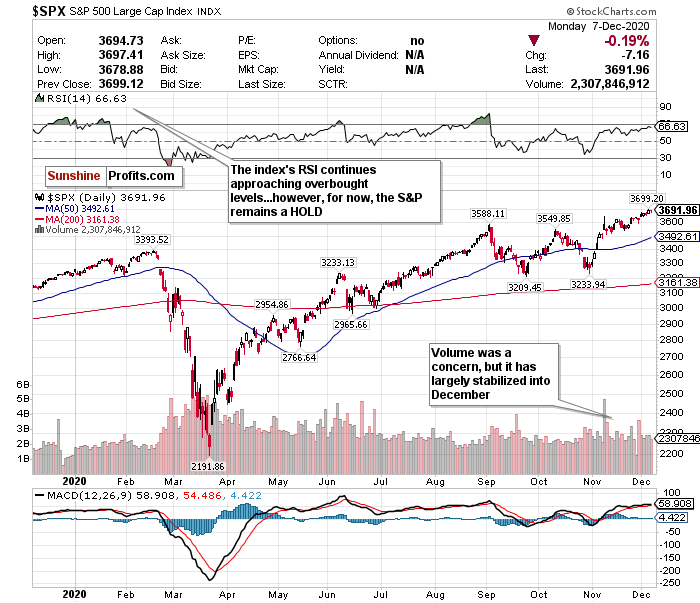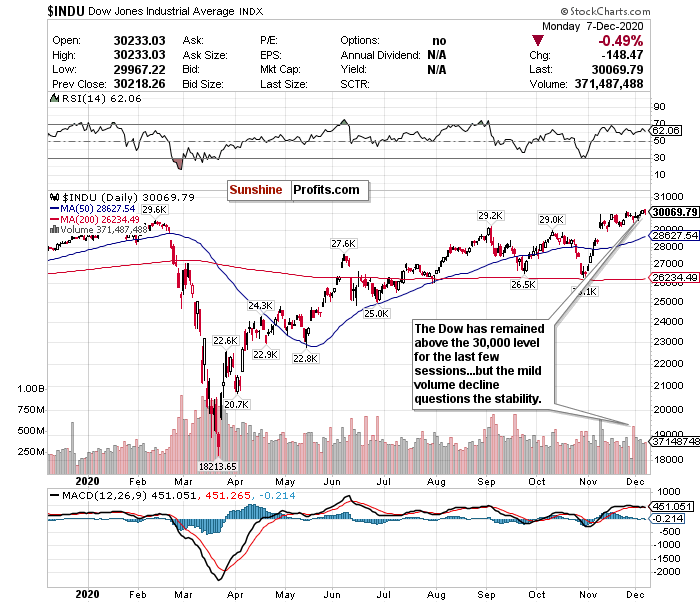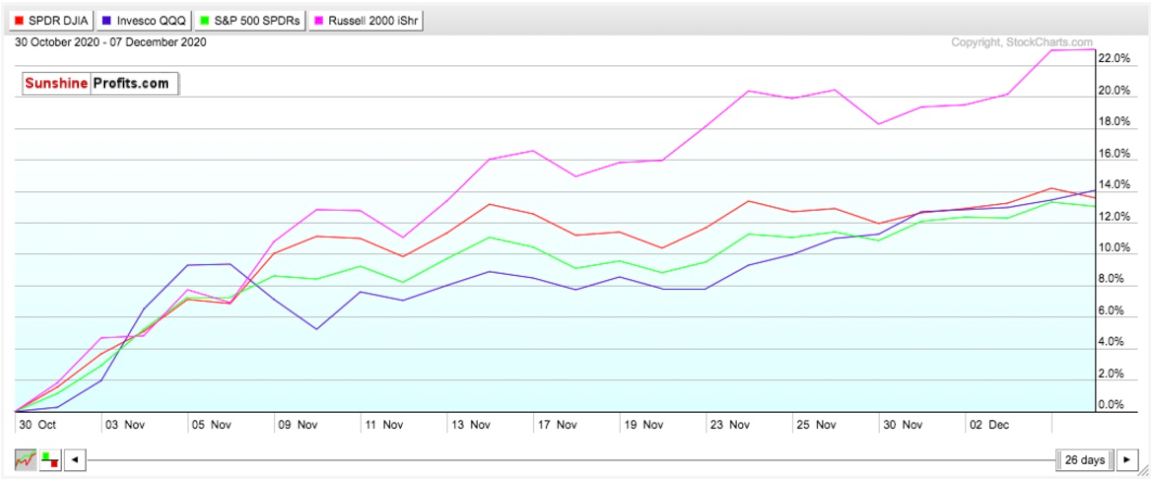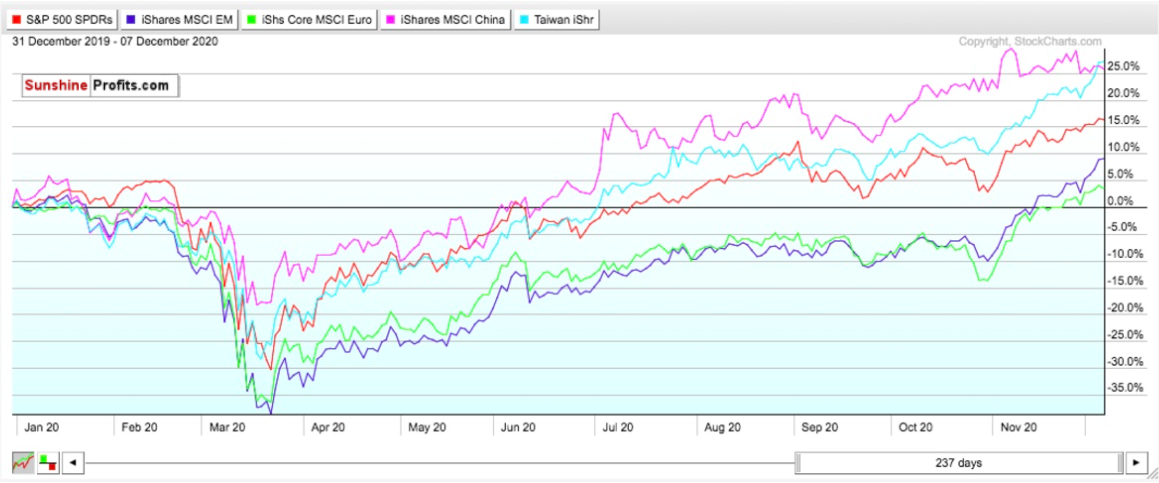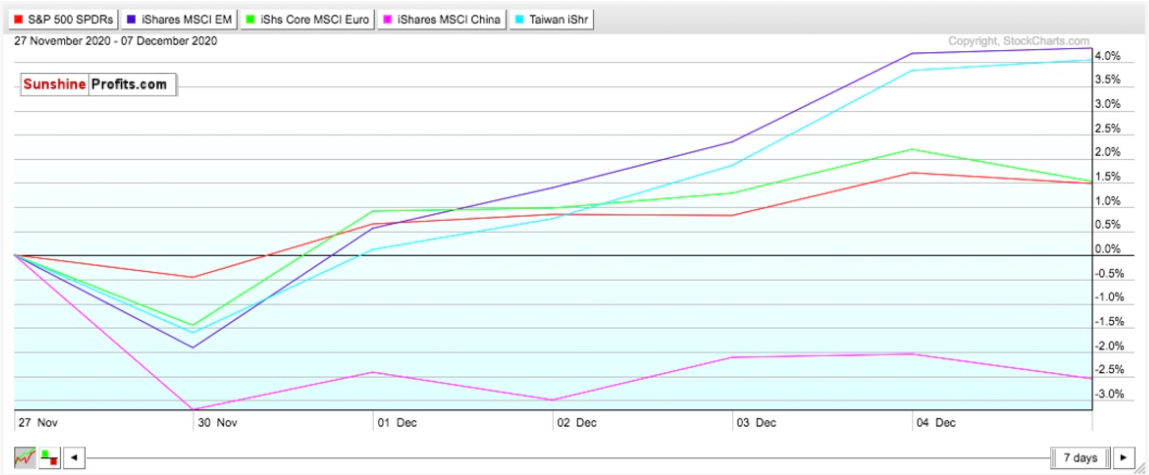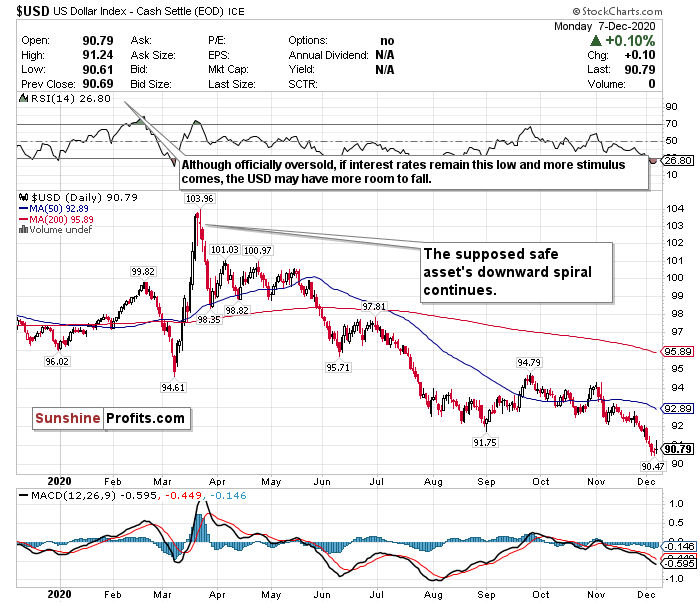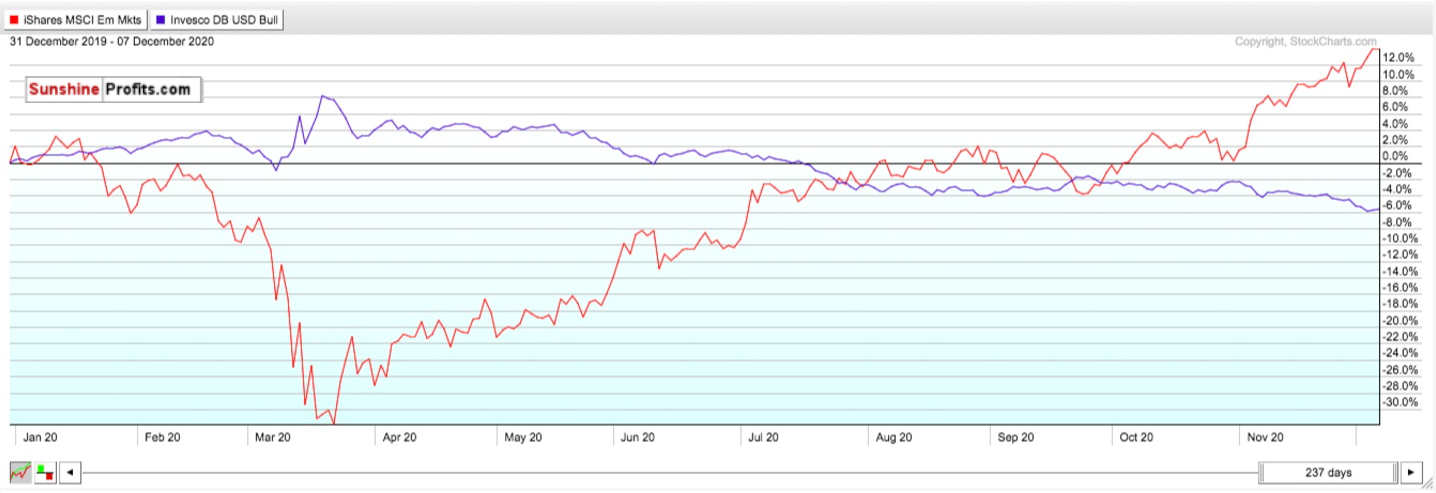The Dow Jones and S&P 500 fell on Monday (Dec 7), while the NASDAQ booked another record close.
News Recap
- The Dow Jones snapped a four-day win streak and closed 148.47 points lower, or 0.5%, at 30,069.79. The S&P 500 also fell 0.2%, while the Nasdaq rose 0.5% to hit another record close of 12,519.95.
- Scorching hot value stocks lagged growth stocks on Monday amid uncertainty over the near-term economic outlook. The iShares Russell 1000 Value ETF (IWD) dipped 0.6%, and the iShares Russell 1000 Growth ETF (IWF) gained 0.4%.
- Intel was the worst-performing Dow stock and fell 3.4%, while energy was the worst- performing S&P 500 sector and slid 2.4%.
- Big Tech led the markets on Monday with Facebook rising 2.1%, and Apple gaining 1.2%.
- Tesla also surged 7.1% and hit an all-time high.
- The U.S. reported a record-high average number of cases over the past seven days of more than 196,200. This is 20% higher than the week-earlier period. The U.S. was also approaching a record-high number of daily Covid-related deaths. These increasing numbers have led some states and cities to re-impose shutdown measures to control the outbreak.
- Despite the surging COVID-19 numbers, lawmakers are still struggling to push through a stimulus package before the end of the year. However, there is apparent progress in pushing a stimulus bill through.
In the short-term, there will be optimistic days where investors rotate into cyclicals and value stocks, and pessimistic days such as Monday where investors rotate into tech and “stay-at-home” names. Other days, like last Friday, the markets will broadly rise without any one specific catalyst. With this much uncertainty comes market unpredictability.
In the mid-term and long-term, there is certainly a light at the end of the tunnel. Once this pandemic is finally brought under control and vaccines are mass deployed, volatility will stabilize, and optimism and relief will permeate the markets. Stocks especially dependent on a rapid recovery and reopening such as small-caps should thrive.
According to Ed Yardeni, president and chief investment strategist at Yardeni Research, “Renewed lockdown restrictions in response to the third wave of the pandemic are likely to weigh on the economy in coming months, but we don’t expect a double-dip…(but) the economy could be booming next spring if enough of us are inoculated against the virus.”
For at least the rest of 2020, markets will wrestle with the negative reality on the ground and optimism for an economic rebound in 2021. Amidst the current fears of a stall in economic recovery with further COVID-19-related shutdowns and no stimulus, it is very possible that short-term downside persists. However, if a stimulus deal passes before the end of the year, it could mean more market gains.
Due to this tug of war between good news and bad news, any subsequent move downwards will likely be modest in comparison to the gains since the bottom in March and the gains since the start of November. It is truly hard to say with conviction that another crash or bear market will come. If anything, the mixed sentiment will keep markets relatively sideways.
Therefore, to sum it up:
While there is long-term optimism, there is short-term pessimism. A short-term correction is very possible. But it is hard to say with conviction that a big correction will happen.
The S&P Has Long-term Upside…But a Blurry Short-term
After hitting three record closing highs last week, the S&P mildly pulled back on Monday. While the S&P has certainly skyrocketed to unprecedented levels at a breakneck pace, there are a few indicators that show that the S&P could face some near-term volatility. But it is difficult to say with conviction that there will be a major downturn.
I am considerably more bullish on the S&P in the long-term than I am in the short-term due to the multitude of headwinds right now combined with the S&P’s valuation. Although the volume has largely stayed stable since Thanksgiving, the RSI of 66.63 keeps the S&P in a HOLD category, while approaching overbought.
According to a survey of market strategists conducted by CNBC, a narrow majority believe that U.S. stocks will continue to rally into 2021, with the S&P 500 rising between 8% and 22% next year from these current levels. This very well could be the case - but I personally believe most of this will happen in the next 6-12 months rather than 1-3 months.
Because of how far and fast the S&P 500 has risen, a further pullback from these elevated levels would not be a shock… but another surge based on good news would not be a shock either. Because of all of the uncertainty, a HOLD for the S&P is an appropriate call. For an ETF that attempts to directly correlate with the performance of the S&P, the SPDR S&P ETF (SPY) is a good option.
Can the Dow Stay Above 30,000?
Despite pulling back on Monday, the Dow Jones remained above the 30,000 level. However, the Dow may be the major index most vulnerable to news and sentiment. Despite breaking past the 30,000 level last Friday (Dec 4), and remaining above it Monday, volume sharply declined. Doubts on the sustainability of the Dow’s rally are no longer only sentiment based- they are technical based as well.
With the RSI still firmly in hold territory, the call on the Dow stays a HOLD.
On pessimistic “sell the news” kinds of days, the Dow will have more downside pressure than other indices. Many cyclical stocks that depend on a strong economic recovery trade on this index, and any change in sentiment can adversely affect their performances.
But it is hard to say with conviction that a drop in the index will be strong and sharp relative to the gains since March, let alone November. But for now and in the short-term, I believe that we could be in a sideways pattern. For an ETF that attempts to directly correlate with the performance of the Dow, the SPDR Dow Jones ETF (DIA) is a strong option.
Can Small-caps Own December Too?
The Russell 2000 small-cap index surprisingly did not decline as much as the Dow and S&P on Monday. This is an index that is especially dependent on news and sentiment, and can experience greater volatility than larger-cap stock indices. Much of this can be attributed to the amount of cyclical stocks in the index that are dependent on the recovery of the broader economy.
Ever since Pfizer announced the efficacy of its vaccine candidate in early November, the Russell 2000 has skyrocketed and considerably outperformed the other major indices. Just look how the iShares Russell 2000 ETF (IWM) compares to the ETFs tracking the Dow, S&P, and Nasdaq in that time frame. Since November, the IWM has risen over 22%. This is nearly 8+% higher than all the other major indices.
If the last 9 months have shown us anything, it’s that Russell stocks will surge on optimistic days, and drop more on pessimistic days. In the long-term, however, small-caps may be the best opportunity to bet on an economic recovery in 2021. But, in the short-term, small-cap stocks may be the most volatile of them all and are a HOLD.
Mid-Term
China Remains a Strong Bet on Emerging Markets...But Do not Ignore Taiwan
Investors remain bullish on emerging markets in both the short-term and medium-term. However, in the short-term it really depends on the region. China, for example, is by far the largest presence in emerging market indices. But do not ignore Taiwan.
While China could outperform once again in December, there are renewed geopolitical tensions to worry about. Earlier last week, Reuters reported on the possible blacklisting of a few Chinese companies, and President-elect Biden said that he would not remove tariffs on China- at least not early on in his administration. The House also passed a bill that could bar Chinese companies from listing on American exchanges if they do not adhere to U.S. auditing standards.
Taiwan adds a similar opportunity for emerging market exposure, without the same type of geopolitical risks. Especially because of their crucial services to the tech and semiconductor industry.
If you look at returns from December 31, 2019 to Monday’s close, and compare the performance of the iShares MSCI China ETF to the iShares MSCI Emerging Markets ex-China ETF, SPDR S&P ETF, iShares Core Europe ETF, and iShares Taiwan ETF the comparison is stunning. After outperforming the others for most of the year, the iShares Taiwan ETF has now overtaken the China ETF’s 2020 returns. The only other ETF that comes remotely close to the China and Taiwan ETF’s performances is the SPDR S&P ETF- and both China and Taiwan’s ETFs outperformed that by nearly 10%. Additionally, the ex-China ETF has only now begun to approach a 10% return while the Europe ETF has only now approached a 5% gain.
But look how Taiwan’s ETF has performed in the last 7 trading days compared to the other ETFs- and especially China.
While the Taiwan ETF and the Emerging Markets ex-China ETF have gained nearly 4% in that timeframe, the China ETF declined by over 2.5%. China may have handled the pandemic better than other countries and continues to demonstrate its ability to handle COVID’s economic shocks. However, keep in mind that this is a regional victory- not just China. Although I am bullish on China in the mid-term, I feel that Taiwan may arguably pose an even stronger opportunity- without the authoritarian or geopolitical headwinds.
For broad exposure to Emerging Markets, you will want to BUY the iShares MSCI Emerging Index Fund (EEM), for exposure to China you will want to BUY the iShares MCHI ETF (MCHI), and for exposure to a regional economic power without the geopolitical risks of China, you will want to BUY the iShares MSCI Taiwan ETF (EWT). Consider the iShares MSCI Indonesia ETF (EIDO) as well for another growing regional economy.
….all while the Dollar Continues to Tank
Although the US Dollar mildly recovered and gained .10% on Monday, it’s dollar is still hovering around its 2-year low, and has plunged in excess of 12% since March. Since the election alone, the dollar index has also declined approximately 4%. I have been calling this dollar weakness all week despite the low level and expect the decline to continue.
Further illustrating the dollar’s decline relative to emerging markets has been the performance of the iShares MSCI Emerging Market ETF (EEM) compared to the Invesco DB USD IDX Bullish ETF (UUP) since January.
Many believe that the dollar could fall further as well due to a multitude of headwinds.
If the world returns to relative normalcy within the next year, investors may be more “risk-on” and less “risk-off.” Which means that the dollar’s value will decline further.
Additionally, because of all of the economic stimulus combined with record low-interest rates, the dollar’s value has been hurt and could be further hurt. Remember, the Fed does not plan on raising interest rates for at least another 2 years. This is an eternity for the dollar’s value.
As the world’s reserve currency, this plunge in value is concerning both in the short-term and mid-term for the US economy. A declining dollar means the strengthening of other foreign currencies- and this has already been happening. Since Nov. 2, the New Zealand dollar has surged 7%, the Australian dollar has climbed 5.5%, the Korean won has advanced 4%, and the Chinese yuan has risen 2.5%- and this may not be the end either.
The plunge of the dollar has been so severe that it is currently trading below both its 50-day and 200-day moving averages. Furthermore, its 200-day moving average is considerably higher than its 50-day, further illustrating the sharp decline.
While the dollar may have more room to fall, according to its RSI, it is comfortably in oversold territory. This MAY be a good opportunity to buy the world’s reserve currency at a discount. But I just have too many doubts on the effect of interest rates this low, government stimulus, strengthening of emerging markets, and inflation to be remotely bullish on the dollar’s prospects over the next 1-3 years.
For now, where possible, HEDGE OR SELL USD exposure.
Pay Very Close Attention to Inflation
Pay very close attention to the possible return of inflation within the next 6-12 months. The Fed has said it will allow the GDP to heat up, and it may overshoot in the medium-term as a result. Although JP Morgan and Goldman Sachs have cut their GDP growth estimates for Q1 2021, pay close attention to what happens in Q2 and Q3 once vaccines begin to be rolled out on a massive scale. It is only inevitable that inflation will return with the Fed’s policy and projected economic recovery by mid-2021.
If you are looking to the future to hedge against inflation, look into TIPS, commodities, gold, and potentially some REITS.
In the mid-term, I have BUY calls on the SPDR TIPS ETF (SPIP), the Invesco Optimum Yield Diversified Commodity Strategy No K-1 ETF (PDBC), the SPDR Gold Shares ETF (GLD), and the iShares Cohen & Steers REIT ETF (ICF).
Long-Term
While the surging spread of COVID-19 and resulting economic shutdowns may drive some short-term concerns, the progress made on the vaccine/treatment front poses significant optimism for 2021 and beyond. With vaccines set to be rolled out this week in the U.K., this finally may be the beginning of the end of the pandemic. However, the next 1-3 months are absolutely crucial. Although news of possible supply chain issues with Pfizer and potential short-term hiccups in the economic recovery are concerning, the long-term outlook for equities, namely value stocks, and cyclicals, could be very positive.
Summary
The end is finally near for 2020- and possibly the pandemic. Thank god. While there is still some short-term tumult, we can officially enter 2021 with some glimmer of hope. But COVID-19 is still here and has not been eradicated. Until that happens, there will inevitably be a tug of war between vaccine optimism and health/economic pessimism.
Please keep in mind that markets are forward looking instruments and are investment vehicles that look 6-12 months down the road. However, it is very plausible that there could be some short-term uncertainty and volatility mixed in. But also remember how sharp and swift the rally was after the crashes in March. Since markets bottomed on March 23rd, here is how the ETFs tracking the indices have performed: Russell 2000 (IWM) up 90.66%. Nasdaq (QQQ) up 80.62%. S&P 500 (SPY) up 66.94%. Dow Jones (DIA) up 63.58%.
Markets long-term always end up going up and are focused on the future rather than the present.
If everything goes well with distributing the vaccines, and the virus can be contained, the short-term volatility may be worth monitoring for opportunities before the eventual mid-term and long-term reality turns positive and stable in 2021.
To sum up all our calls, in the short-term I have a HOLD call for:
- the SPDR S&P ETF (SPY),
- Invesco QQQ ETF (QQQ)- (but consider trimming gains and/or selling),
- SPDR Dow Jones ETF (DIA), and
- iShares Russell 2000 ETF (IWM).
However, I am more bullish for these ETFs in the long-term.
In the mid-term, I suggest avoiding the US Dollar. Try gaining exposure in the emerging markets instead.
I have BUY calls on:
- The iShares MSCI Emerging Index Fund (EEM),
- the iShares MSCI China ETF (MCHI),
- the iShares MSCI Taiwan ETF (EWT), and
- the iShares MSCI Indonesia ETF (EIDO)
Additionally, because I foresee inflation returning as early as mid to late 2021…
I also have BUY calls on:
- The SPDR TIPS ETF (SPIP),
- the Invesco Optimum Yield Diversified Commodity Strategy No K-1 ETF (PDBC)
- the SPDR Gold Shares ETF (GLD), and
- the iShares Cohen & Steers REIT ETF (ICF)
Thank you.
Matthew Levy, CFA
Stock Trading Strategist


